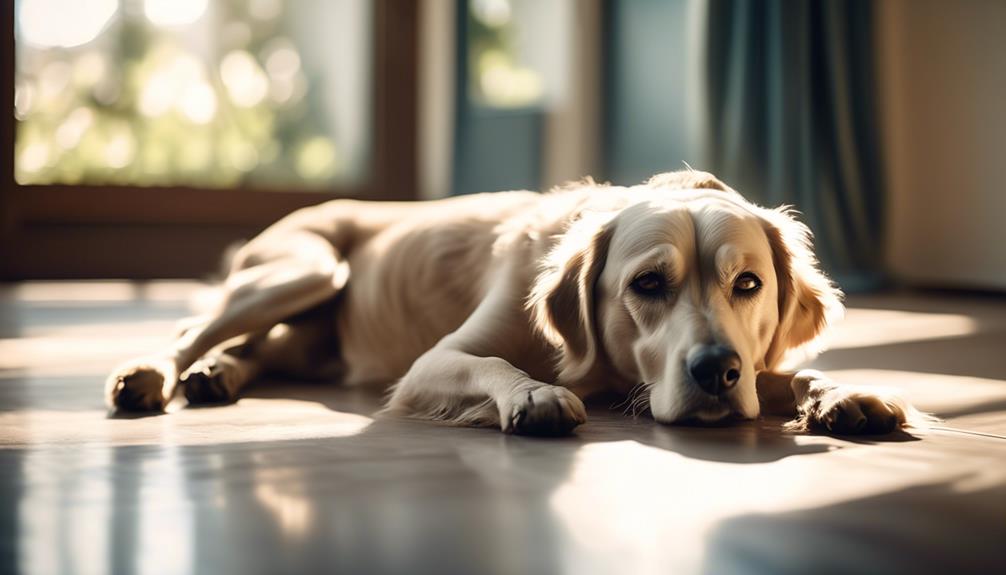Guide your dog through a series of stretches and yoga postures designed for older adults. These exercises are adjusted to their speed and focus on relieving the pains associated with aging.
You’ll find that incorporating a routine of gentle pose flow can significantly enhance their joint health, while a dedicated stretching series might just bring newfound flexibility to their spine.
And let’s not forget the serene power of breathing exercises to ease the mind and soothe the spirit.
Each step you take together on this path is not just a moment of bonding but a stride towards maintaining their vigor and vitality.
Begin using these routines to improve your dog’s later years, making them more comfortable and revitalizing. Keep reading to learn how to incorporate these practices into your daily walks with your beloved dog.
Key Takeaways
- Gentle pose flow and mindful breathing can enhance joint health and mobility in older dogs.
- Stretching series, such as bow pose and begging pose, can improve spinal flexibility and overall agility in dogs.
- Relaxing breathing exercises can soothe the nerves and promote a serene state of mind in dogs.
- Creating a serene environment, being consistent, and practicing with love and care are essential for optimal results in yoga and stretch routines for older dogs.
Gentle Pose Flow for Joint Health
To nurture your older dog’s joint health and mobility, let’s explore a series of gentle poses that can alleviate stiffness and enhance flexibility with loving attention to their comfort.
Begin with mindful breathing to create a serene environment. Gently guide your dog into a comfortable standing position, encouraging them to stretch one leg at a time. This targeted pose helps ease the joints into movement, reducing discomfort.
Next, transition to a soft, flowing sequence that encourages gentle stretching. Support your dog as they attempt a mild bend, carefully lifting a paw if they’re willing. This will improve flexibility and can ease joint pain that often comes with age. Ensure each movement is slow and considerate, never forcing a pose that causes distress.
As you progress, focus on the quality of each stretch, observing your dog’s response. If they appear relaxed, you’re fostering an atmosphere of trust and aid. Your attentive presence allows them to feel secure as they engage in these therapeutic exercises.
Stretching Series for Spinal Flexibility
Building on the foundation of joint health, let’s now focus on a series of stretches that aim to enhance your older dog’s spinal flexibility, fostering improved mobility and comfort. A supple spine is crucial for your dog’s overall agility and can help reduce the risk of injuries that may occur due to stiffness and brittle movements.
Begin by gently encouraging your dog to stand in a neutral position. Carefully guide them into a slow, controlled bow, where their chest moves towards the ground, stretching the spine upwards. This ‘play bow‘ pose isn’t only a natural stretch but also a way to alleviate any discomfort they might be feeling.
Next, with the same tender guidance, help your dog to sit back on their haunches, gently lifting their front paws off the ground if they’re comfortable. This ‘begging‘ pose further stretches the back and enhances their posture and balance.
Always be attentive to your dog’s comfort levels, never forcing a position. Remember, the goal is to relieve stiffness and improve circulation, contributing to their overall well-being.
These stretches, done consistently and with love, can make a significant difference in the quality of life for your aging companion.
Relaxing Breathing Exercises
Gently guiding your older dog through relaxing breathing exercises can soothe their nerves and promote a serene state of mind, enhancing their overall comfort and health. As you embark on this soothing journey with your dog, understand that your calm demeanor is key. Your older dog can pick up on your emotions, so it’s essential that you’re relaxed as you assist them through these exercises.
Start by finding a quiet space where both of you won’t be disturbed. Encourage your dog to lie down beside you. Place your hand gently on their chest to feel the rhythm of their natural breathing. As they breathe in, envision stress departing from their body, and as they breathe out, picture a wave of peace washing over them.
Frequently Asked Questions
Can Yoga Help Manage My Older Dog’s Arthritis or Chronic Pain Conditions?
Yes, yoga can be a lifeline for your dog’s arthritis, offering gentle stretches to soothe aches and improve flexibility, thereby enhancing their well-being and showing your deep care for their comfort.
How Often Should I Engage My Senior Dog in Yoga and Stretching Routines?
You should incorporate stretching and yoga into your daily routine, gently guiding them through the movements to promote flexibility and reduce discomfort. Aim for brief, regular sessions rather than long, sporadic ones.
Are There Any Risks or Signs I Should Watch Out for When Practicing Yoga With My Older Dog?
You should watch for signs of discomfort or pain, such as whimpering or reluctance to participate. Always ensure exercises are gentle and stop if you notice any distress or unusual behavior.
How Can I Encourage My Older Dog to Participate in Yoga if They Seem Uninterested or Anxious?
To motivate your companion, start with short, positive sessions. Treats and praise work wonders, creating a calming environment that entices participation. Patience is key; never force involvement, fostering a serene bond instead.
Can Yoga and Stretching Improve My Older Dog’s Balance and Prevent Falls?
Yes, yoga and stretching can enhance your balance and prevent falls by strengthening muscles and improving flexibility, which is particularly beneficial as you age and seek to maintain mobility and independence.


